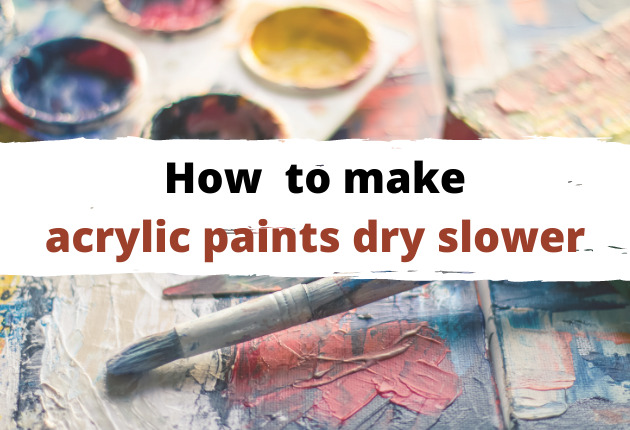Last Updated on March 15, 2024 by Masha Eretnova
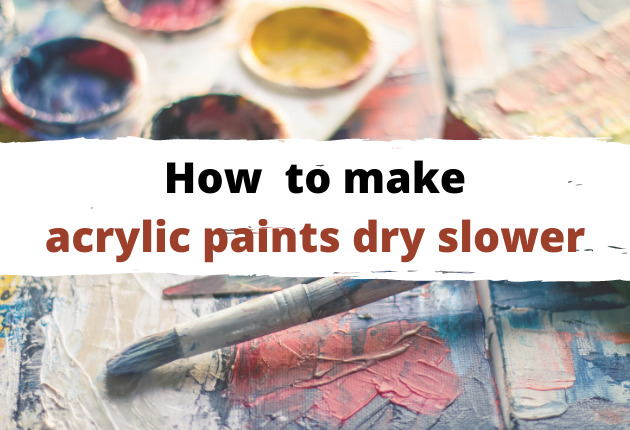
Let me guess…your acrylic paint dries way too fast before you’re able to finish the layer and details.
I feel you. Some acrylics dry in under 5 minutes and we need to make them dry slower.
To make acrylic paint dry slower you can use slow-drying mediums or Golden Open acrylics. Adding water will also slightly slow down the drying of acrylics.
To understand how to slow down the drying time of acrylic paint, first of all, let’s see how the paint is drying and what we can use if we wish to extend the work time.
Table of Contents
This article contains affiliate links. It means no extra cost for you but a little commission (2-3%) for me to support my hobby and blog. Thank you!
How long does it take for acrylic paint to dry?
On average, artist-quality, professional acrylic takes 20-30 minutes to touch dry if used in a thin layer. Thicker layers will take 1-2 hours depending on the environment you’re painting in.
Acrylic paint is fully cured in 6 – 12 hours in a well-aired, cool room.
Why does acrylic paint dry fast?
Acrylic paint is water-based. The process of acrylic paint drying is the process of water and some other agents’ evaporation.
Based on it, anything that makes water evaporate faster, like a thinner layer of paint, heat, and fast-drying additives, will speed up the drying process.
How to Make Acrylic Paint Dry Slower
1 – Planning and sketching
You can influence acrylic paint dry time even before you start painting. The better you plan the colors you will use and the approximate amount you’ll need, the fewer problems you will have with hardened paints.
Another good piece of advice is to sketch in pencil or charcoal. This will allow you to know exactly when and what color or mix to use.
Related post: 11 Easy Methods on How to Sketch on Canvas Before Acrylic Painting
2 – Painting in the cooler room
If you want to make acrylic paint dry slower:
- Paint in a cooler environment, e.i. basement or with closed curtains.
- Higher humidity (50% +) will also extend the drying time because evaporation can not happen. Just use a humidifier.
- You can also use the air conditioner or a fan to cool the room, but if your workplace has high humidity, the fan will only make acrylic dry faster.
3 – Painting outdoor
During cooler days you can paint outdoors to slow the drying process.
However, you should be painting when it is freezing cold as paint will simply freeze and harden.
If you like to paint outdoors, make sure you follow the same guidelines: no air flows, high humidity, and temperature below 65F or 18C.
Here are some extra tips on how to make acrylic paint dry slower outdoors:
- Work in a shaded area, protected from air flows and sun. If the day is hot, try to paint early in the morning or late in the evening.
- Use a sprayer if the air is dry.
4 – Using a primed surface
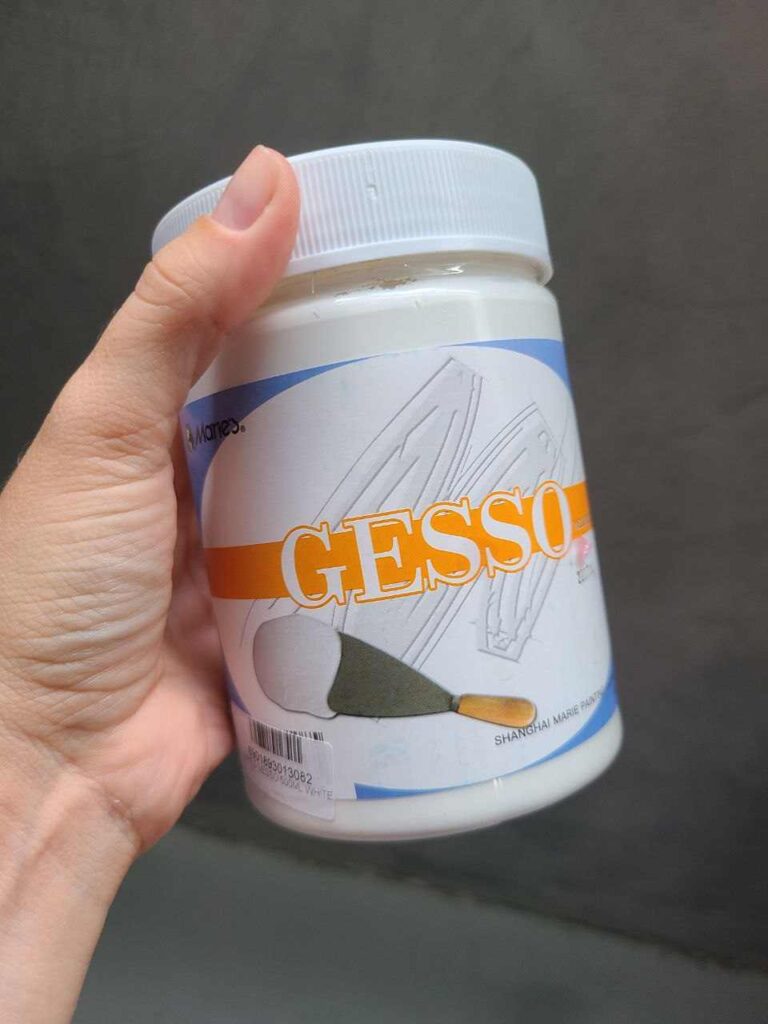
The general rule for painting is to use primed surfaces.
It can also make acrylic paint dry slower because any unprimed absorbent surface will soak the paint and make it dry faster. The more porous and absorbent the surface is, the faster the paint will dry.
- If you are using canvas, don’t forget to gesso it before painting. Here is the How to article.
- If you are painting on the wood, same – prepare the surface. Here is the full guide about priming wood.
5 – Moisturizing the back of the canvas
If you’re painting on the canvas, one of the easiest and most effective ways to make your acrylic paint dry slower is to spray the back of the canvas with water.
This additional water slows down the evaporation process and the drying process as well.
Please, do not “soak” your canvas with water, too much water can destroy both canvas and paint and weaken paint adhesion!
How to moisture the back of the canvas to make acrylic paint dry slowly:
- Fill the spray bottle with water
- Turn your canvas over to the back
- Spray the canvas with water
- Spray again when the canvas is dry.
6 – Using a wet palette
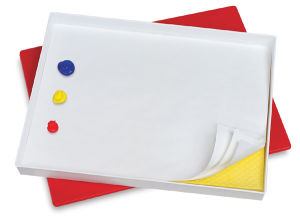
A wet palette is a very popular way to make your acrylic paint dry longer. It is a platter with a sponge and moisture palette paper for your acrylic paint to rest on. Just add some water before painting and it’s ready.
- A wet palette allows you to work with the paint for several hours and days.
- Avoid paint waisting and make blending easier
- Easy to clean compared to a normal palette
You can buy a wet palette on Amazon or make your own at home!
7 – Using non-absorbent palettes
First of all, you can reuse simple food containers. Spray paint with water before closing the container and it will keep the paint from drying for days.
By non-absorbent palette, I mean not only plastic but also glass, a tile, etc, anything that will not soak your paint as paper or wood does.
Some palettes were made specifically for keeping your paints fresher longer, like the Mijello Peel-Off Palette or glass palette (they are quite expensive for a palette).
8 – Spraying the palette with water
The simple way to make your acrylics dry slower with no extra cost is to periodically spray your palette. For better results use distilled water.
Spray paint as often as you need to, but avoid pouring too much water because it will affect paint quality.
Just use an empty and clean spray bottle from any beauty product:
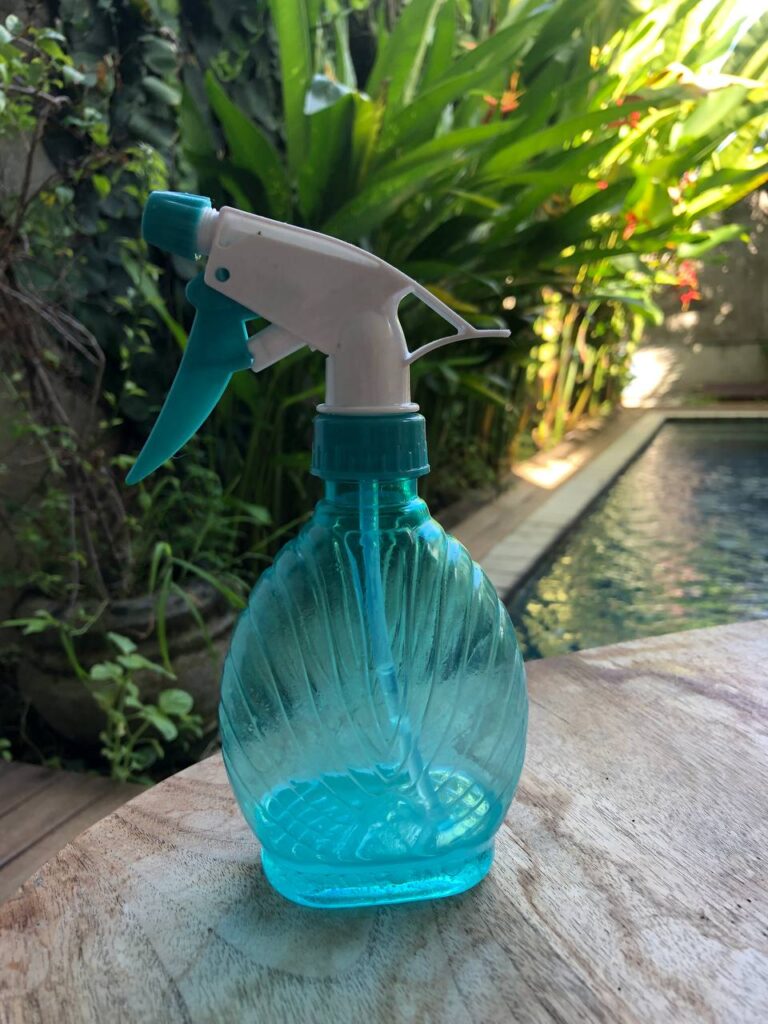
9 – Spraying the palette with a wetting spray
As we know, water is not the best option to thin paint or make it dry slower.
To avoid the negative impact of the water, replace it with some professional wetting acrylic mediums, such as Liquitex Palette Wetting Spray for example.
The wetting spray contains slowing agents, improves color blending, and does not affect paint quality.
10 – Use paint with a longer open time
Open time is a period of time when we can work with this acrylic paint. When the paint is slow-drying, it means its open time is longer than usual. Basically, acrylic paint is fast-drying, but some brands make paints with a longer open time.
Slow-drying paint can be only used in thin layers (< 1 mm), each layer can be applied only after the last one is fully dried.
The best slow-drying paint now is Golden Open Acrylics:
| Wet | Work time | Can still be reopened | Touch dry | Cured | |
| OPEN Acrylics | 30-60 min. | 1-3 hrs. | ~12 hrs. | 24+ hrs. | 14+ days |
Golden Open Acrylics come in 73 different colors and sets. These paints are more expensive than normal ones.
I absolutely LOVE Open acrylics, If you have ever worked with oils, Golden Open are oils of acrylics. Buttery, slow to dry, and thick. Here is a painting I made with Open acrylics while they stayed wet the whole time.
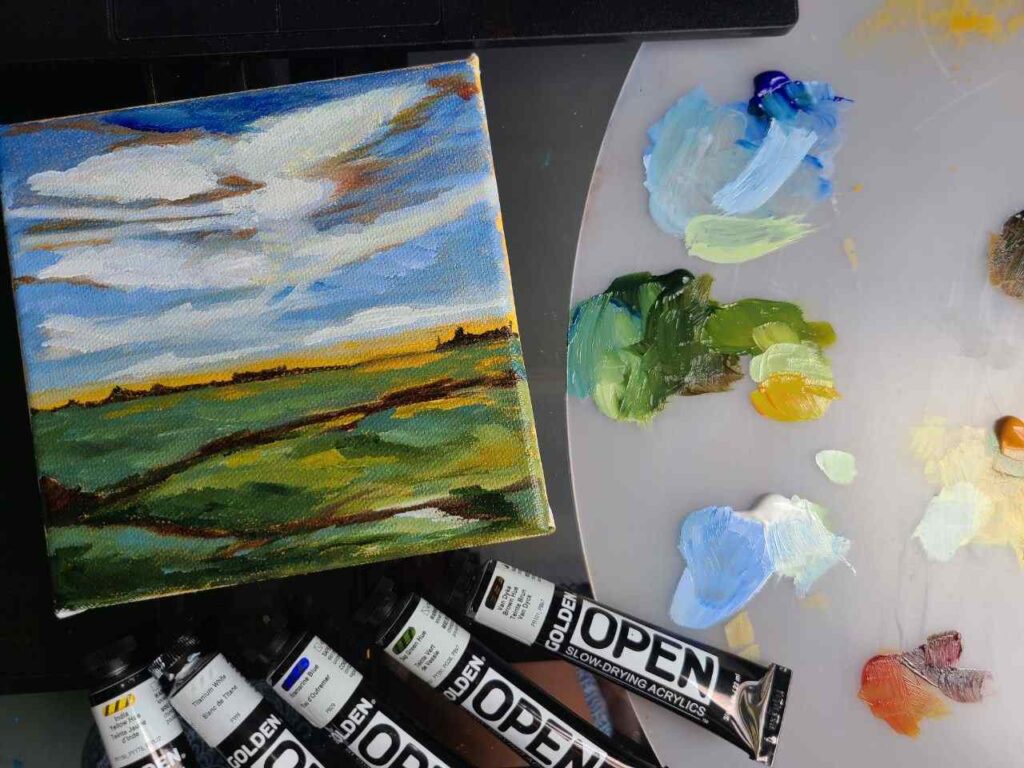
Another option that is basically not slow-drying but can act like one is Atelier Interactive Acrylic Paints. Mixing this paint with the Atelier Unlocking Formula extend work time and slow drying, you can also reactivate the paint again and again.
Note that you need to wait until the painting is fully cured before varnishing.
11 – Using artist-grade acrylic paint
There are 2 grades of paint: student and artist grade. The difference between them is the quality and the ratio of pigment to binder.
Usually, we assume that student paint dries faster and the cheaper the paint is, the faster it dries.
Artist-grade paint stays open a bit longer but it is still not slow drying.
Artists grade paint examples: Deco Art Traditions Acrylic paints, Chroma Atelier Interactive Artists’ Acrylic Paints, Pebeo Artists’ acrylics, Utrecht Artists’ Acrylic Paint, etc.
Check them here: Best Acrylic Paint For Beginners in 2024 [Cheap to Pro]
12 – Using paint retarders
If any of the other methods suit you, you can also use slow-dry mediums or retarders to make acrylic paint dry slowly.
Retarders slow down the evaporation process and give you an extra 30 minutes (less or more depending on the brand) to paint.
First of all, with a paint retarder, you can prolong the work time of any acrylic paint, you don’t have to buy expensive Open by Golden.
Using paint retarders (also acrylic gel) is an easy and effective way to make your paint dry slower. You only need to mix it on your palette with paint in a 1:1 ratio (follow the manufacturer’s guidelines, some mediums should not exceed 15% of the mix)
You can mix a retarder with paint on the palette, but you can also use a liquid version and spray it over each layer. This will give you more work time.
One more option is using an extender to let the paint stay wet longer. They can reduce the paint quality if you add too much of an extender.
Some affordable slow-dry or extender mediums:
| Golden Acrylic Retarder | Check price |
| Liquitex Slow-Dry Medium – *BEST* | Check price |
| Winsor & Newton Slow Drying Medium | Check price |
| Blick Artists’ Acrylic Retarder | Check price |
| Tri-Art Acrylic Retarder | Check price |
| Grumbacher Artists’ Acrylic Retarder | Check price |
| Old Holland New Masters Retarder Gel Medium | Check price |
| Blick Matte Acrylic Extender | Check price |
| Winsor & Newton Galeria Extender | Check price |
To avoid wasting money you can always try to make a DIY retarder at home with simple ingredients.
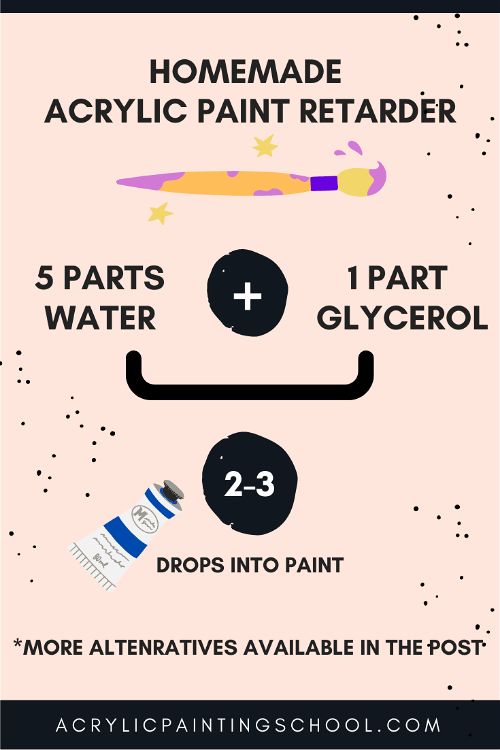
13 – Using acrylic glazing liquids
A substitute for a retarder could be an acrylic glazing liquid such as Golden Glazing Liquid.
Not all glazing liquids will work, only those that have a slow-drying effect. Check the label before buying!
A glazing liquid also improves the paint flow without affecting paint or canvas quality. It extends the working time of acrylic paint which means it will make acrylic paint dry slower.
14 – Thicker application
The basic rule of painting is that the thicker the layer is, the longer it will take to dry. It means that only by applying thicker layers you will slow down a little bit the dry time of your paint. And this method is almost free 🙂
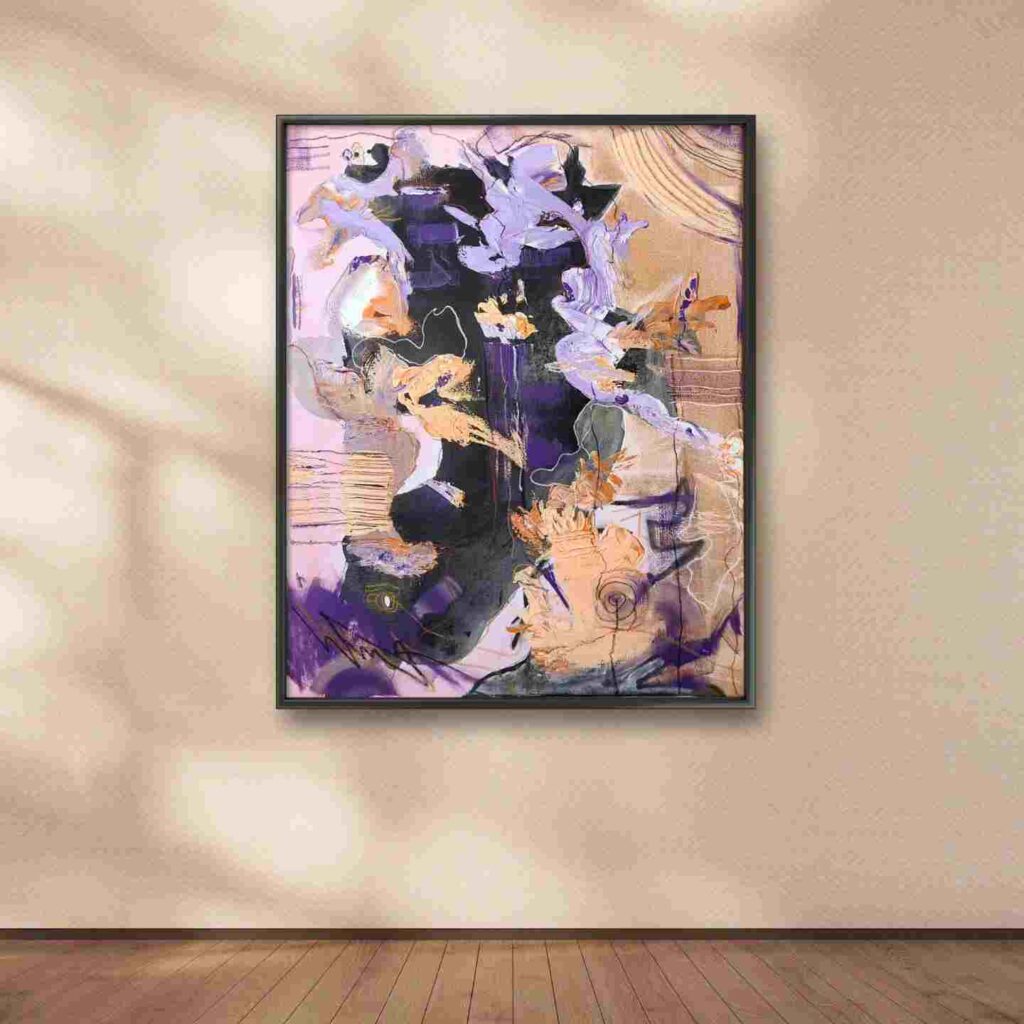
The fact is you still use the same paint, so it still dries as fast as it dried before and we will probably not be able to “control” how much time you have.
Experiment and make some notes on how slowly the paint will dry. Make sure all layers are drier and fully cured before you apply the varnish.
15 – Using plastic wrap
This method does not involve wet canvas, paint, or using mediums. This is about how we store a finished painting session.
Remember about humidity? By covering your painting you will create something like a “Greenhouse effect”.
- Spray your painting with water.
- Cover it with plastic wrap or another non-absorbent and non-breathing material
- Leave it for 3-4 days
- Continue painting!
Final Thoughts
Extending acrylics’ drying time is not that difficult and I am sticking to my personal top 3 solutions: retarders, Open acrylics, and wetting the paint/canvas.
My misting bottle is always on my desk and it becomes a habit after you use it for some time.
I don’t think we need to invest in expensive mediums or special tools, but I also know that just water doesn’t do the job.
Test what works best for your practice and budget.
If you have any questions or ideas, please share in comments.
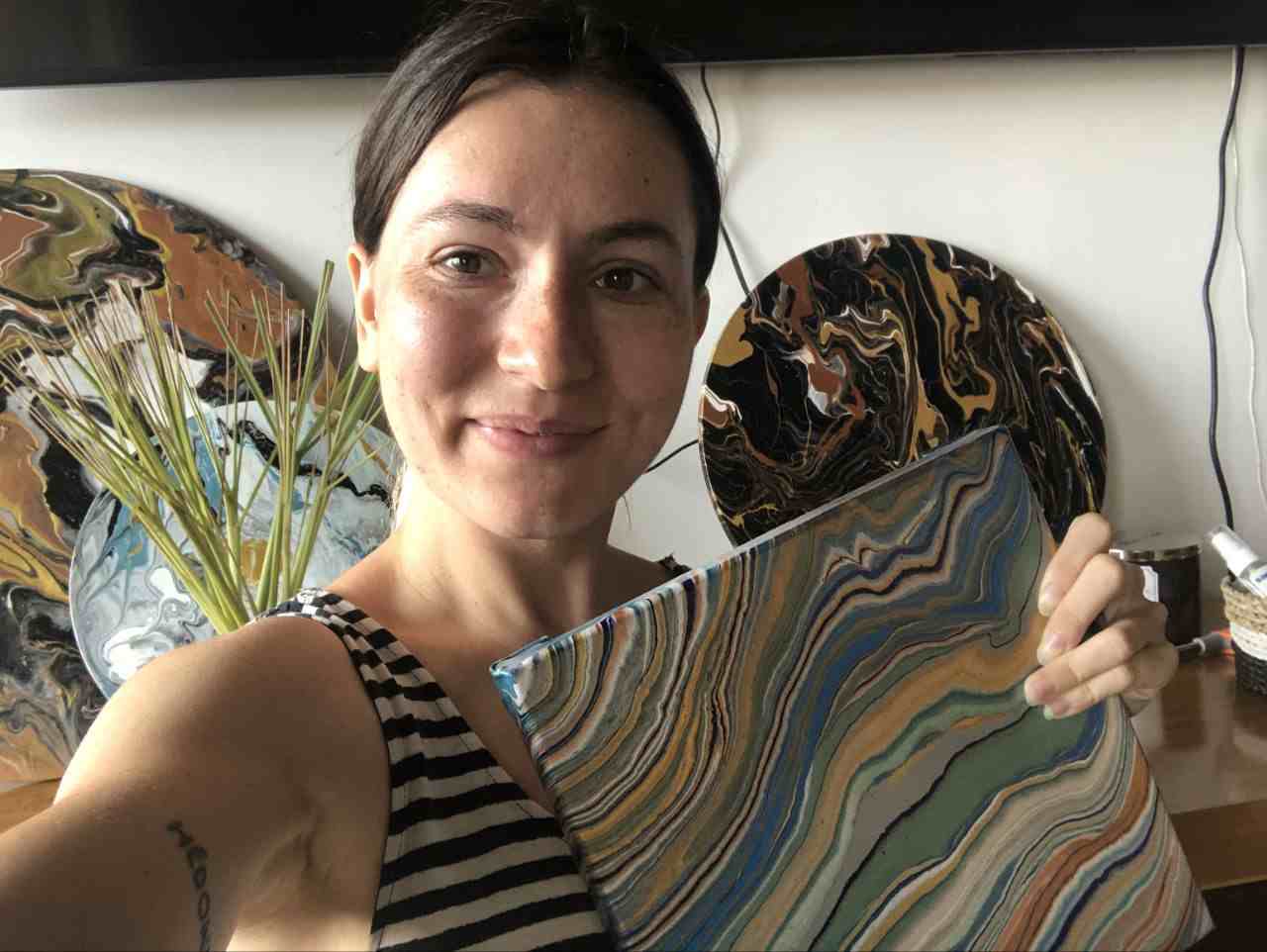
Masha Eretnova, born in 1991, is a Buenos Aires-based certified teacher, artist, and member of the Professional Artist Association with 20+ years of personal painting journey.
She started painting and drawing very early and is now an international abstract artist and educator passionate about acrylic painting, gouache, and crafts.
Her works are part of international exhibitions and contests, including ArtlyMix (Brazil), Al-Tiba 9 (Spain), Exhibizone (Canada), Italy, and many more.
Besides her artistic pursuits, Masha holds a post-grad diploma in Teaching Film Photography and 2 music school diplomas: piano and opera singing.
Last update on 2024-07-26 / Affiliate links / Images from Amazon Product Advertising API
